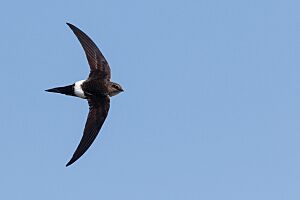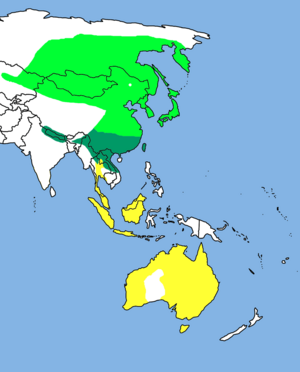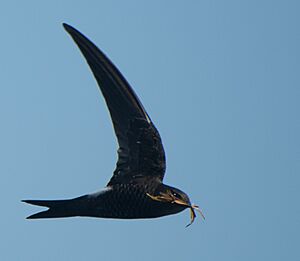Pacific swift facts for kids
Quick facts for kids Pacific swift |
|
|---|---|
 |
|
| Conservation status | |
| Scientific classification | |
| Genus: |
Apus
|
| Species: |
pacificus
|
 |
|
|
Breeding range
(ranges are approximate)Breeding range of three former subspecies Non-breeding |
|
The Pacific swift (Apus pacificus) is a speedy bird that belongs to the Swift family. It makes its home and raises its young in eastern Asia. This bird is a strong migrator, meaning it travels long distances. During the northern hemisphere's winter, it flies south to places like Southeast Asia and Australia.
The Pacific swift looks a bit like its cousin, the common swift, with its dark, almost black feathers. But you can tell it apart by a clear white band across its lower back (rump) and a "scaly" look on its belly. Both male and female swifts look the same. Young birds have pale edges on their wing feathers, which adults don't. Their main call is a loud screech, typical of the swift family.
These amazing birds live in many different climates and places. They build their nests in safe spots like caves, cracks in rocks, or under the roofs of buildings. Their nest is a half-cup shape, made of dry grass and other soft bits they collect while flying. They stick it together with their own saliva and attach it to a vertical surface. Female swifts usually lay two or three white eggs. The parents take turns keeping the eggs warm for about 17 days until they hatch. The baby swifts stay in the nest for a long time. If the weather is bad and parents can't find enough food, the young can survive for days without eating by using up their body fat.
Like all swifts, the Pacific swift eats only insects that it catches while flying. It often hunts higher in the sky than many other swifts. The Pacific swift has a large population and a wide breeding area. It doesn't face many threats from predators or human activities. Because of this, it is listed as a species of "least concern" by the International Union for Conservation of Nature. Sometimes, these birds fly far off course and have been seen in places like the US, New Zealand, and even rarely in Europe!
Contents
What is a Pacific Swift?
Swifts are a family of birds called Apodidae. The Pacific swift belongs to the Apus group, which are known for their dark, shiny feathers, forked tails, and sharp, pointed wings. The name Apus comes from the Greek word apous, meaning "without feet." This refers to their small, weak legs. Swifts spend almost all their time flying, so they don't need strong legs for walking! The word pacificus in its name refers to the Pacific Ocean, near where it lives.
For a while, scientists thought there were five types (subspecies) of Pacific swifts. But now, three of these have been recognized as their own separate species. This means the Pacific swift is part of a "fork-tailed swift" group, which includes these newly separated species.
How to Identify a Pacific Swift
The Pacific swift is one of the larger Apus swifts, growing to about 17–18 cm (6.7–7.1 in) long. Its wingspan can be 43 to 54 cm (17 to 21 in). Female swifts are usually a little heavier than males.
This bird looks a lot like the common swift, but it has longer wings and a head that sticks out more. Its tail fork is deeper, and the white band on its rump (lower back) is wider. Its upper body is black, except for this white rump band and a slightly grayer head. The underside of its body is black, but white edges on the feathers make its belly look somewhat scaly when you see it from below. Its eyes are brown, and its small beak and very short legs are black. Young swifts look almost the same as adults, but their wing feathers have pale edges.
It's usually easy to tell a Pacific swift apart from other birds. The white-rumped swift looks similar but is thinner and has a very deeply forked tail. Sometimes, a common swift might have a white rump due to a genetic difference, but the Pacific swift has a deeper tail fork, longer wings, a bigger head, and that special patterned belly.
What Does it Sound Like?
When Pacific swifts gather in flocks near their breeding areas, they make typical swift screams. These calls include a trilled tsiririri or a harsher spee-eer. Their calls are similar to the common swift's cries, but they are softer and less wheezy. When they are in their winter homes, they are quieter, but they still make various chirps and buzzing sounds.
Where Do Pacific Swifts Live?
The main group of Pacific swifts breeds in eastern Asia. This area stretches from the Ob River in the northeast to Kamchatka and east to Japan. They are very strong migrants, flying south to spend winter in southern Indonesia, Melanesia, and Australia, including Tasmania. Many thousands of them fly through coastal Malaysia, Sumatra, and Java.
Pacific swifts are amazing long-distance travelers. Sometimes, they fly far off their usual path. They have been seen in places like Brunei, the Maldives, New Zealand, and even the Seychelles. In the US, they have been spotted in the Pribilof and Aleutian Islands. There have also been a few rare sightings in Europe.
These birds spend most of their lives flying. They are not limited to certain land types or climates. They breed from the Arctic to warmer parts of China, and from sea level up to at least 3,000 m (9,800 ft) high in Japan. You can often find them near human towns and cities. In winter, they tend to stay in lower areas. In Australia, they live in dry areas as well as in towns and along the coast. Huge groups of thousands of swifts can appear when there are hot, strong winds. Pacific swifts often fly and feed with white-throated needletails. When they are not nesting, Pacific swifts probably sleep while flying, just like common swifts do.
Life Cycle and Behavior
Reproduction and Nesting
Most swift species build their nests in rocky areas. Many also use human buildings as a safe place to nest. The Pacific swift is a colonial bird, meaning they nest in groups. They choose sheltered spots like caves, cracks in vertical rock faces (including sea-cliffs), or under the eaves of houses.
Their nest is a half-cup shape made of feathers, dry grass, and other light plants they collect while flying. They use their own saliva to glue these materials together and attach the nest to a ledge or a vertical surface. They usually lay two or three white eggs. Both parents take turns sitting on the eggs for about 17 days until they hatch. The chicks are born without feathers and are blind. Both adult swifts feed and care for the chicks, which usually leave the nest after about 40.5 days.
Swifts lay fewer eggs than many other birds of similar size. Their eggs also take longer to hatch, and the chicks stay in the nest for a longer time. Young swifts can even get heavier than their parents! They can survive for long periods without food and can slow down their feather growth if they don't get enough to eat. These special abilities help them survive when food is scarce. When conditions are good, many young swifts survive. In one large colony, about 73.5% of eggs hatched, and 63.6% of the chicks successfully left the nest.
What Do They Eat?
All swifts eat insects they catch while flying. Pacific swifts have been seen eating bees, wasps, termites, moths, and flies. A study in China found that they eat many different kinds of insects, including some that are harmful to farms and forests. This means they actually help farmers!
Pacific swifts usually hunt higher in the sky than other swifts that live in the same area. They often share their hunting space with white-throated needletails. They typically feed at heights up to 300 m (980 ft). They only fly closer to the ground when the weather is bad. They often hunt near areas of low air pressure, which helps lift insects from the ground and gives the swifts extra lift for flying.
Swifts fly in circles through swarms of insects. These flocks can be tens or hundreds of birds, and sometimes even tens of thousands in Australia! In Siberia, Pacific swifts feed later into the evening than common swifts, sometimes until midnight. Migrating swifts have even been seen flying with bats in the Philippines. The young swifts are fed balls of insects that the parents have bound together with saliva. During bad weather, when food is harder to find, young swifts might not be fed for days. They survive by using up the fat stored in their bodies.
Who are Their Enemies?
Swifts spend most of their lives flying. Not many birds are fast or agile enough to catch them. Hobbies (a type of falcon) are one of the main birds that can hunt them. Their nest sites are usually in places that are hard for snakes or mammals to reach.
Pacific swifts can have tiny creatures living on their feathers, called feather mites. They can also have biting parasites like louse flies, bat bugs, and sucking mites. Some chewing lice and tapeworms have also been found inside them.
Conservation Status
The Pacific swift lives in a very large area, covering more than 10,000,000 km2 (3,800,000 mi2). We don't know the exact number of birds, but they are common throughout their breeding range, and their population doesn't seem to be shrinking. Because of this, the International Union for Conservation of Nature lists them as a species of "least concern".
There don't seem to be any major threats to these birds. Few animals hunt them, and they are not tied to one specific type of habitat. Some birds might die from accidents or get tired when they get lost during migration. For example, the first Pacific swift seen in the Western Palaearctic (Europe and parts of Asia) was found resting on a North Sea gas platform. But swifts generally have high survival rates and live for a long time. The common swift, which is a close relative, has been known to live for 21 years!
Images for kids







